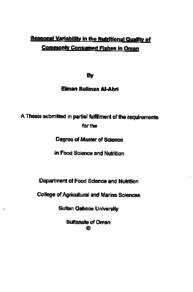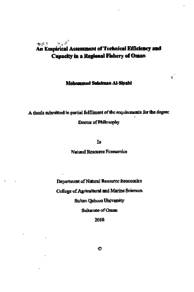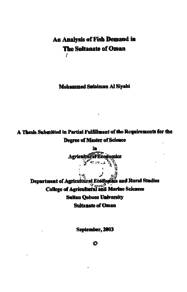Document
Seasonal Variability in the Nutritional Quality of Commonly Consumed Fishes in Oman
Publisher
Sultan Qaboos University
Gregorian
2007
Language
English
Subject
English abstract
The present study was conducted to determine the chemical composition and nutritional quality of 10 commonly consumed fish species (kingfish, yellowfin tuna, longtail tuna, sharks, emperor, grouper, yellowfin goatfish, sardine, Indian mackerel, and sea bream) in Oman. Five representative samples of each specie were procured from the local fish market in Muscat during the two seasons in summer (June) and autumn (September), 2005. The fish samples were processed for determining the condition factor (k), flesh percentage, proximate chemical composition, as well as for fatty acids and mineral contents. Significant (p < 0.05) differences were observed in the condition factor, flesh percentage, and proximate chemical composition of different fish species. Seasonal variability however only affected the moisture, ash and fat contents but not the protein content of fish. Kingfish and shark showed lower condition factor (0.5) whereas yellowfin tuna, emperor and yellowfin goatfish showed higher condition factor (1.4). Grouper showed the lowest flesh percentage (31.7%) while kingfish showed the highest flesh percentage (71.5%). The moisture, ash, total fat, crude protein contents and energy values of various fish species ranged between 67.0-78.2%, 1.1-1.5%, 0.6-6.2%, 19.1-26.1%, and 86-136 kcal/100g of fish flesh respectively. Twenty different fatty acids were identified in these fish species, which differed significantly (P«< 0.05) among various fish species. The seasonal variability affected (P<0.05) the total saturated fatty acids (SFA) and monounsaturated fatty acids (MUFA) but did not affect the total polyunsaturated fatty acids (PUFA) contents. However, the seasons*species interactions were significant (P<0.05). The highest concentration of fatty acids was observed for saturated fatty acids (SFA), followed by monounsaturated (MUFA), and polyunsaturated fatty acids (PUFA) respectively. Shark and sea bream showed the lowest SFA content (0.3%), whereas sardine showed the highest SFA content (2.9%). Sixteen important minerals of nutritional significance were determined in these fish species. Significant (P <0.05) differences were also observed in the mineral composition of various fish species.
1 variability however did not affect the mineral composition of fishes. The results of the present study indicated that significant variability exists in the nutrient composition of various fish species however; the seasonal variability affected the moisture, ash and total fat, SFA and MUFA but not the protein, PUFA and mineral contents of fishes. It may be concluded that commonly consumed fishes in Oman represent an excellent source of protein, essential fatty acids and important minerals and should remain a regular part of Omani diet.
Member of
Resource URL
Arabic abstract
إن الهدف الأساسي لهذا البحث هو تحديد الخواص الكيميائية و القيمة الغذائية لعشرة أسماك أكثر إستهلاكا في سلطنة عمان (الكنعد والجيذر والسهوة والقرش والشعري والهامور والسلطان إبراهيم والساردين والضلعة والكوفر). تم سحب خمس عينات من كل نوع من الأسماك لقياس حالة الأسماك (condition factor)، ونسبة اللحم فيها، وإجراء التحاليل التقريبية، ولتحديد انواع وكميات الأحماض الدهنية، و نسبة الأملاح بهذه الأسماك. أجريت هذه التحاليل لموسمين مختلفين من السنة، موسم الصيف (يونيو) وموسم الشتاء (سبتمبر) لعام ۲۰۰۰. أظهرت التحاليل تفاوت في نتائج حالة الأسماك ونسبة اللحم والتحاليل التقريبية مع إختلاف الأسمالی المستخدمة. إختلاف الموسمين أظهر تفاوت في نسبة الرطوبة والرماد ونسبة الدهون. ولم تتأثر نتائج البروتين بإختلاف الموسمين. بينت هذه الدراسة بأن أسماك الكنعد و القرش أظهرت اقل حالة صحية condition) (factor ( 0 ، 5 % ) بينما أظهرت أسماك الجيذر والشعري والسلطان إبراهيم أعلى حالة صحية (%1 ، 4). نسبة اللحم كانت قليلة في أسماك الهامور (۳۱ ، ۷ %) بينما كانت عالية في أسماك الكنعد (%۰، ۷۹). نسبة الرطوبة والرماد والدهون والبروتين وقيمة الطاقة تراوحت بين: ۹۷٫۰-۷۸۰۲%، ۱٫۱-۱ , ۰ %، ۰٫۹-6 , ۲ %، ۱۹٫۱۔ % ۲۱٫۱، ۱۳۶ - ۸۹ kcal / ۱۰۰g على التوالي. تم تحديد عشرون نوعا مختلفة من الأحماض الدهنية والتي اختلفت نسبها بإختلاف نوع الأسماك. أثر إختلاف الموسمين ( 0 . 05>P) على نتائج الأحماض الدهنية المشبعة والأحادية التشبع بينما لم يؤثر ( 0 . 05 <P) في نتائج الأحماض الدهنية متعددة التشبع. في حين أثر إختلاف نوع الأسماك مع إختلاف الموسمين على نتائج جميع هذه الأحماض الدهنية. أظهرت الأحماض الدهنية المشبعة اعلى نسبة تلتها الأحماض الدهنية الأحادية التشيع في حين ظهرت الأحماض الدهنية متعددة التشبع بنسب منخفضة. تم تحديد 16 عنصر من الأملاح المفيدة لصحة الإنسان، تفاوتت نتائجها (۰٫۰۰>P) بإختلاف نوع الأسماك بينما لم يؤثر إختلاف الموسمين على نتائج الأملاح (005 <P). أظهرت نتائج هذا البحث بأن القيمة الغذائية للاسماك تتفاوت حسب نوعية الأسماك. أما إختلاف الموسمين فلم يؤثر إلا على نتائج الرطوبة والرماد والدهون و الأحماض الدهنية المشبعة والأحادية التشيع ولم يؤثر على نتائج البروتين و الأحماض الدهنية متعددة التشبع و الأملاح. نستنتج من هذا البحث بأن الأسماك العمانية تحتوي على قيمة غذائية عالية ومصدر جيد للبروتين والأحماض الدهنية و الأملاح اللازمة لبناء جسم الإنسان.
Category
Theses and Dissertations



